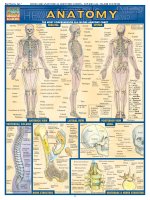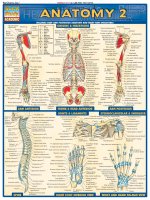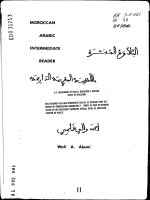BarCharts quickstudy accounting vol 2
Bạn đang xem bản rút gọn của tài liệu. Xem và tải ngay bản đầy đủ của tài liệu tại đây (853.29 KB, 2 trang )
BarCharts, Inc.®
ACCOUNTING
FUNCTIONS
A. Helps an organization to achieve its goals and
objectives by gathering, organizing, and
communicating information about its activities
B. Main uses
1. Internal managers: Short-term planning, long range
planning, controlling routine operations, and nonroutine decisions
2. External parties: Making decisions about the company
based on information presented in financial statements
governed by GAAP
C. An accounting system uses 3 types of activities
1. Score-keeping to accumulate and classify data
2. Attention-directing to focus on problems and opportunities
3. Problem-solving to recommend the best course of action
D. Themes that guide the design of all accounting systems
1. Cost/benefit criteria
2. Behavioral implications; effects on the manager’s
decision making
E. Accounting’s position in the organization
1. Line authority: Downward over subordinates
2. Staff authority: Downward, laterally, or upward
3. The controller: Top accounting officer in an organization,
measures and reports on operating performance
F. Accountants are expected to adhere to standards of
ethical conduct
COST BEHAVIOR
COST-VOLUME RELATIONSHIPS
A. Cost drivers: Activities that cause costs to
be incurred
B. Variable costs vs. fixed costs
1. VC change in direct proportion to the cost driver
2. FC do not change immediately with the cost driver
C. Cost-volume-profit analysis
1. Break-even point: Level of sales at which revenues = expenses
2. Contribution (CM) margin/unit = sales price/unit - VC/unit
3. Sales - VC - FC = net income
4. Break even in units = FC/CM per unit
5. Break even in $ = FC/CM ratio
6. Target profit can be added to FC
D. Relevant range: Limit of cost-driver activity where
FC/VC assumption is valid
VARIATIONS OF COST BEHAVIOR
A. Cost drivers and cost behavior
1. Cost behavior is assumed linear over some relevant
range of activities or cost drivers.
2. Cost behaviors that combine characteristics of both
fixed and variable cost behavior
a. Step costs: Either fixed or variable, changed abruptly
at interval of activity because the resources and their
costs come in divisible chunks
b. Mixed costs: Contain elements of FC & VC
B. Management’s influence on cost functions
Through decisions about product or service attributes,
capacity, technology, and policies to create incentives
to control costs
C. Measure cost behavior as a function of appropriate
cost drivers
1. Total cost=FC+(VC x cost driver)
2. Apply activity analysis in choosing a cost driver
3. Plausibility and reliability when choosing a cost
function for accuracy and usefulness
D. Methods of measuring cost functions (Y=F+VX)
1. Cost = Fixed cost + (Variable cost x # of Units)
2. Engineering analysis: what costs should be
3. Accounting analysis:
a. Volume related cost driver versus what cost could
have been
b. Classify each account as a VC or FC
4. High-low, visual-fit, and least-squares methods:
separate F & V past data to predict costs
WORLD’S #1 QUICK REFERENCE GUIDE
RELEVANT INFORMATION
AND DECISION MAKING
A. Criteria for relevant information
1. Predicted future cost: Differ among alternatives
2. Past data: Irrelevant
3. Cost or revenue that remains the same regardless of the
alternative: Irrelevant
B. Special Sales order
1. Should accept when additional revenues > additional costs
2. Fixed costs normally unaffected
C. Deletion or addition of products or departments
1. Avoidable costs: Will not continue
2. Unavoidable costs: Continue
D. Optimal use of limited resources
1. Emphasize product with largest total profit
contribution per unit of the limiting factor
2. # of units/limiting factor x (CM)/unit = total CM/unit
of limiting factor (CM = Contribution Margin)
E. Role of costs in pricing decisions
1. Marginal cost: Additional cost for one more unit produced
2. Marginal revenue: Additional revenue from one more
unit sold
3. Price elasticity: Effect of price changes on sales volume
F. Influences on pricing in practice
1. Legal requirements:
a. Predatory pricing
b. Discriminatory pricing
2. Competition
3. Costs
4. Customer demand
5. Target costing: Design a product that can be produced at
a low enough cost to provide an adequate profit margin
G. Opportunity cost
1. Max profit forgone by choosing an alternative
2. Economic in nature
H. Outlay cost
1. Requires cash outlay
2. Accounting in nature
I. Differential = incremental cost
1. Difference in total cost between alternatives
2. Used in differential analysis
J. Make-or-buy decisions
1. Identify quantitative and qualitative factors
2. Focus on relevant costs
K. Joint product costs: Occur when two or more
products have relatively significant sales values
1. Not separately identifiable until split-off point
2. Identify separable costs beyond split-off point
3. Identify joint costs prior to split-off point
4. Decide whether to sell or process further
a. Differential analysis
b. Opportunity cost analysis
c. Joint costs are irrelevant
INTRODUCTION TO COST
SYSTEMS
A. Classification of costs
1. Cost accumulation and cost objectives
a. A cost is a sacrifice or giving up of resources for a purpose.
b. A cost objective is something that managers want to
know the cost of.
2. Direct and indirect costs
a. Direct costs can be identified specifically and
exclusively with a given cost objective.
b. Indirect costs cannot be identified with a given
cost objective.
3. Manufacturing costs
a. Direct-material costs (DM): Costs of all materials
that are physically identified as a part of the
manufactured goods
b. Direct-labor costs (DL): The wages of all the labor
that can be traced to manufactured goods
c. Factory-overhead costs (F/O): All costs other than
DM or DL
4. Prime costs = DM+DL
5. Conversion costs = DL+F/O
B. Types of accounting systems
1. Activity-based cost accounting
a. Accumulate overhead costs for each activity
b. Assign the costs to cost objects
2. Cost management system
a. Measure the resources used
b. Assess the effects of costs of changes
3. Just-in-time system
Purchase and produce when needed in the production
C. Cost accounting for I/S and B/S
1. Product cost: Identified with goods purchased or
produced for resale and become expenses (CGS) when
inventory is sold
2. Period cost: Expensed during the current period
without inventory stage
D. Two approaches to costs on I/S
1. Absorption costing: All V and F manufacturing costs
are treated as product cost
2. Contribution approach: Only V manufacturing costs
are treated as product cost
a. Sales-VC=Contribution Margin
b. Contribution Margin-FC = operating income
BUDGETING
MASTER BUDGET: OVERALL PLAN
A. Budgeting over time
1. Strategic plan: Overall goals and objectives
2. Long-range planning: For 5-10 yrs
3. Capital budget: Planned expenditures for facilities,
equipment, etc.
4. Master budget: Summarize all subunits
a. Operating budget: Focus on I/S and its schedules
b. Financial budget: Effects of operating and capital
budgets on cash
B. Advantages of budgets
1. A planning tool
2. Maintaining control by evaluating actual to budget
3. Enhanced communication and coordination
C. Preparation of master budget
1. Operating budget
a. Prepare sales budget
b. Estimate cash collections
c. Prepare purchases budget
d. Estimate disbursements for purchases
e. Prepare operating expense budget
f. Estimate disbursements for operations
2. Financial budget
a. Prepare detailed cash budget
b. Prepare budgeted B/S
D. Difficulties - All budgets rely on sales budget
1. Past patterns used
2. Estimates
3. Volatile economic environment
FLEXIBLE BUDGETS AND
STANDARDS FOR CONTROL
A. Static budget = master budget
1. Performance report: Actual results vs. original plan
2. Master budget variances
a. Favorable or unfavorable
b. Not useful for management by exception
B. Flexible budget = variable budget
1. Adjust for changes in cost-drivers
2. Prepared for a range of activity
3. Reflect FC and VC behavior
4. Flexible budget variances: Flexible budget vs. actual results
5. Activity level variances: Flexible budget vs. master budget
Flexible Budgets and
Standards... (Continued)
C. Isolation of variances and their causes
1. Effectiveness: Degree to which a goal or target is met,
measured by sales-activity variance
2. Efficiency: Inputs used in relation to outputs,
measured by flexible budget variance
3. Expected cost: Most likely to be attained
4. Standard cost: Should be attained; Budget for one unit
D. Flexible budget variances
1. Variances from material and labor standards
a. Price (rate) variance: Difference between actual input
price and standard price
b. Usage (quantity or efficiency) variance: Difference
between quantity of input used and quantity allowed
for actual output
2. Provide feedback
3. Overhead (OH) variances
a. Variable OH efficiency variance
b. Variable OH spending variance
MANAGEMENT CONTROL
SYSTEMS
A. MCS: an integration of management accounting tools
1. Organizational goals: #1 in designing MCS (broad)
2. Organizational sub-goals: Means of achieving
organization’s overall goals (mid-range)
3. Organizational objectives: Day-to-day guidance (specific)
4. Balance of goals, sub-goals, and objectives:
Overemphasis on short term to the detriment of long
range threatens achievement of organization’s basic goals
B. Designing a MCS
1. Working within constraints: MCS must fit organization’s
structure (ie: whether it is by function or division)
2. Identification of responsibility centers
a. Cost center: Where costs are accumulated
b. Profit center: Measures revenue less costs
c. Investment center: Measures net income to invested capital
3. Weighing costs and benefits: Maximum benefits at
minimum costs
4. Motivation of employees
a. Goal congruence: Individuals and groups aim at
same goals
b. Managerial effort: Exertion toward goal or objective
5. Design of internal controls: Prevent, detect errors &
irregularities and promote operational efficiency
a. Accounting controls: Separation of duties, etc.
b. Administrative controls: Budgets for planning,
controlling, and evaluating
6. Development of measures of performance: For both
financial & non-financial performance measures
C. Control and measurement of financial performance
1. Uncontrollable costs: Cannot be affected by
management within a given time span
2. Controllable costs: Influenced by managements’ decisions
3. Contribution margin
4. Contribution by segment-controllable by responsibility
center managers
5. Unallocated costs
D. Control and measurement of non-financial
performance
1. Quality control
a. Prevention: Costs to prevent defects/substandard service
b. Appraisal: Costs to identify defects/substandard service
c. Internal failure: Costs to scrap or rework
d. External failure: Customer dissatisfaction
2. Control of time cycle
3. Control of productivity
MANAGEMENT CONTROL
IN DECENTRALIZED
ORGANIZATIONS
A. Centralization vs. Decentralization
1. Cost/benefit criteria
2. Profit centers and decentralization
B. Transfer pricing
1. At cost
2. Market based
COST ALLOCATION
3. VC based
4. Negotiated
5. Use of incentives
6. Need for many transfer prices
7. Multinational transfer pricing
INTRODUCTION
C. Performance measures and management controls
1. Motivation > performance > rewards
2. Agency theory > performance > rewards > risk
1. Prediction of economic effects of decisions
2. To obtain desired motivation
3. Income and asset measurement
4. To justify cost or obtain reimbursement
D. Measures of profitability
1. Return on investment (ROI) = income / investment
2. Residual income = NI - imputed interest
C. Types
E. Invested capital can be defined as:
1. Allocation of costs to appropriate units
2. Reallocation of costs from one unit to another
3. Allocation of a particular unit to products or services
1. Total assets
2. Total assets employed
3. Total assets - current liabilities
4. Stockholders’ equity
D. Allocation of costs to final products or services
1. Allocate production related costs to their operation,
production or revenue producing department
2. Select one or more cost drivers in each production department
3. Allocate the total cost accumulated in Step 1 to products
or services using cost drivers specified in Step 2.
F. Keys to successful management control systems
1. Focus on controllability
2. Management by objectives
CAPITAL BUDGETING
ACTIVITY BASED COSTING
Assignment of cost to products or services in
proportion to the benefits received from that cost
ANALYZING LONG-RANGE
DECISIONS
A. Assigns costs to activities
A. Discounted cash flow models
1. Net present value (NPV) method
a. Total project approach: Choose largest NPV
b. Differential approach: Choose if NPV is positive
2. Internal rate of return (IRR) method- choose if IRR
> desired rate of return
3. Risk assessment and sensitivity analysis
4. Complications: Income taxes, inflation, mutually
exclusive projects, and unequal lives
B. Pay-back method: P = I/O
1. Pay-back time = Initial investment / Annual cash flow
2. Does not measure profitability
3. Ignores time value of money
C. Accounting rate-of-return (ARR) method:
ARR = (O - D)/I
1. (Increase avg. operating inc. - depr.) / initial investment
2. Ignores time value of money
D. Performance evaluation
1. Conflict: Evaluations based on accounting measures
can deter from making major long-term decisions with
large initial investments
2. Reconciliations of conflict
a. Post audit: Monitor and evaluate projects
b. Base management evaluations on different priorities
TAXES AND INFLATION
A. Marginal income tax rate
Tax rate paid on additional amts of pretax income
B. Recovery period
Number of periods assets are depreciated for tax purposes
C. Tax shields; deductions protect that amount of
income from taxation
D. Accelerated depreciation
1. Writes off assets quicker than straight-line method
2. Tax avoidance (minimizing and delaying taxes)
3. Double declining balance depreciation: (100%/# of
years asset is to be depreciated) x 2
1. Initial investment
a. Cost of old equipment: Effect on tax cash flows
b. Cost of new equipment is relevant
2. Do not double count: Equipment investment is a onetime outlay not to be double-counted as an outlay in the
form of depreciation.
3. Relation to income tax cash flow: Income tax cash
effect relevant (Not the book value or depreciation)
F. Gains or losses on disposal
1. Losses produce tax savings and gains produce tax
expenditures
2. Gains are still more desirable than losses
G. Capital budgeting and inflation
H. After-tax impact of operating cash inflows
Inflow x (1-tax rate)
B. Cost drivers
OVERHEAD APPLICATION:
VARIABLE AND
ABSORPTION COSTING
A. Variable vs. absorption costing
1. Accounting for fixed manufacturing overhead
a. Variable costing method: FFO is excluded
b. Absorption costing method: FFO is included
2. Variable method
a. Apply all variable manufacturing costs to goods produced
b. Fixed FO is expensed as incurred
c. I/S separates costs into categories of fixed and
variable
3. Absorption method
a. Apply all variable manufacturing costs plus part of
fixed FO to each product
b. I/S separates costs into categories of manufacturing
and non-manufacturing
c. Fixed overhead rate = budgeted fixed
overhead/expected cost driver activity
d. Production-volume variance: Actual production
deviates from the expected volume used
B. Fixed overhead and absorption costs of product
1. Variable and fixed unit costs
2. Production-volume variance = applied fixed
overhead-budgeted fixed overhead
a. Actual production volume does not coincide with
expected volume
3. Fixed overhead rate depends on expected activity
level chosen
4. Actual costing: Actual materials, actual labor, and
actual variable and fixed overhead
5. Normal costing: Actual materials, actual labors, and
budgeted rates for FO
6. Standard costing: Budgeted rates
PRICE: U.S. $3.95 CAN $5.95
E. Depreciation and equipment replacement
1. Nominal rate: Quoted market interest rate
a. Includes an element of inflation
b. Use for minimum desired rate of return
2. Depreciation Deductions: No allowance
inflationary effects
A. Assignment of each cost to the cost objective
B. Purposes
for
Customer Hotline: 1-800-230-9522
ISBN-13: 978-142320002-4
ISBN-10: 142320002-0
hundreds of titles at
quickstudy.com
NOTE: Due to its condensed nature, use this QuickStudy® guide as
a guide, but not as a replacement for expert, in-depth advice.
All rights reserved. No part of this
publication may be reproduced or
transmitted in any form, or by any
means, electronic or mechanical,
including photocopy, recording, or
any information storage and
retrieval system, without written
permission from the publisher.
©2002, 2003 BarCharts, Inc. 1106









